This series documents the use of mules at Gallipoli for medical and resupply operations. In addition to the mules used by the Australian Imperial Force, there were Indian and Zionist Mule Corps operating at Gallipoli.
The Gallipoli Peninsula was unsuitable for cavalry, however, a large number of horses, mules and donkeys were landed on the peninsula for use as riding, draft and pack animals.Simpson and his donkey have come to symbolise the Australian use of mules at Gallipoli. John Simpson Kirkpatrick \enlisted in the Australian Imperial Force, serving at Gallipoli the following year as Private John Simpson in the 3rd Field Ambulance, Australian Army Medical Corps. He served from the time of the landing at Gallipoli on 25 April until he was killed in action on 19 May. Simpson became famous for his work as a stretcher-bearer. Using one of the donkeys brought in for carrying water, he transported wounded men day and night from the fighting in Monash Valley to the beach on Anzac Cove. He was killed by machine-gun fire while carrying two wounded men and was buried on the beach at Hell Spit.The war diary of the 3rd Field Ambulance commended "the excellence of the work performed by Pte Simpson continuously since landing". Simpson was posthumously Mentioned in Despatches. His first donkey was known as Abdul, Murphy, or Duffy
Unlike many of the Australian troops, all the Indians who fought were professional soldiers. The units included the 29th Indian Infantry Brigade. a mountain artillery brigade and, mule transport. The Mule Corps comprised of 650 men and more than 1,000 mules to transport supplies to troops on the peninsula where motor transport was impossible. Historians believe almost 1,400 Indians died at Gallipoli and up to 3,500 were wounded.
On 17 April 1915 the Zion Mule Corps sailed from Egypt to Lemnos, and then onto Gallipoli. The Corps consisted of 562 mostly Palestinian Zionists, five British officers, eight Jewish officers and 750 mules. The corps was divided in two, with one section working for the British 29th Division and the remainder assigned to the ANZACs. The Zion Mule Corps served throughout the campaign in Gallipoli, and were evacuated in December 1915. By the close of the campaign 14 members of the corps had been killed or had died of illness and 25 had been wounded. Prior to the final evacuation the corps had to kill their mules so that they did not fall into the hands of the Turks.
